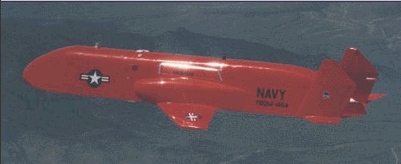Teledyne Ryan BQM-145 Peregrine
In 1988, a joint services requirement called for a new air- and ground-launched mid-range UAV for both aerial reconnaissance and aerial target missions. This program was originally known as JSCAMPS (Joint Services Common Airframe Multiple Purpose System), but was soon renamed to UAV-MR (Unmanned Aerial Vehicle - Medium Range) by the JPO (Joint Program Office) for UAVs. As their entry into the competition, Teledyne Ryan designed the Model 350 as a derivative of the Model 324 Scarab. Flight tests of the company-funded Model 350 POC (Proof-of-Concept) vehicle began in August 1988, and in May 1989, Teledyne Ryan was announced as winner of the UAV-MR competition. A contract for full-scale development of the BQM-145A Peregrine UAV was subsequently awarded.
The BQM-145A is powered by a single Teledyne CAE 382-10C (F408-CA-400) turbofan engine. It can be launched from F-16 and F/A-18 aircraft or from the ground using a zero-length laucher and a MK 129 solid-propellant rocket booster. The Peregrine can fly fully autonomous missions, using a GPS/INS-based flight control system, which can be preprogrammed with waypoint, speed, altitude and heading commands. A self-contained transportable GCS (Ground Control Station) can be used to transmit commands during the mission. The UAV is recovered by a parachute (or optionally a parafoil) system for a soft landing over land or water, or for mid-air retrieval. The primary payload planned for the BQM-145A was the ATARS (Advanced Tactical Airborne Reconnaissance System), an optical/IR imaging system which can provide day and night target imagery.
 |
| Photo: USAF |
| YBQM-145A |
While the production BQM-145As were to be of metal construction, the first two of 25 contracted FSD vehicles were built of composites. These vehicles were designated YBQM-145A, and the first powered flight occurred in May 1992. It was originally planned to procure more than 500 BQM-145A UAVs for the USAF, Navy and Marine Corps. In 1993, however, the ATARS payload was cancelled, and the Navy and Marines withdrew from the program. As the USAF apparently couldn't afford to fund the BQM-145A on its own, the whole UAV-MR program was finally cancelled in October 1993. Six BQM-145A vehicles under construction were completed, and the first of these made its first flight (ground launch) in February 1997. Northrop Grumman (which had taken over the BQM-145 program after it had acquired Teledyne Ryan) continued to market the vehicle as a general purpose medium-range UAV for some years after that, but apparently without success.
Specifications
Note: Data given by several sources show slight variations. Figures given below may therefore be inaccurate!
Data for BQM-145A:
| Length | 5.59 m (18 ft 4 in) |
| Wingspan | 3.20 m (10 ft 6 in) |
| Height | 0.86 m (2 ft 9.9 in) |
| Weight | 980 kg (2160 lb) |
| Speed | Mach 0.85 |
| Ceiling | 12200 m (40000 ft) |
| Mission Radius | 650 km (350 nm) |
| Endurance | 2 hours |
| Propulsion | Teledyne CAE F408-CA-400 turbofan; 4.4 kN (1000 lb) Booster (ground launch): MK 129 MOD 0 solid-fueled rocket; 53.3 kN (12000 lb) for 2.6 s |
Main Sources
[1] William Wagner, William P. Sloan: "Fireflies and other UAVs", Midland Publishing, 1992
[2] Kenneth Munson (ed.): "Jane's Unmanned Aerial Vehicles and Targets, Issue 15", Jane's, 2000
Back to Current Designations Of U.S. Unmanned Military Aerospace Vehicles
Back to Directory of U.S. Military Rockets and Missiles
Last Updated: 13 November 2002